Additional notes (click to expand)
Commemorative
Christopher Colombus's expediton found inhabitants of Santo Domingo, smoking tobacco in 1492. In 1560, Jean Nicot de Villemain (1530-1600), French Ambassador to Lisbon, brought tobacco seeds as a 'wonder drug' to the French Court. In 1586 the botanist Jaques Dalechamps called it Herba Nicotiana after Jean Nicot.
Neuwinger, HD. (1996). African Ethnobotany: Poisons & Drugs, Chapman & Hall page 837
Horticulture
An annual, with a long fibrous root, stem erect, round, hairy, and viscid; it branches near the top and is from 90 to 182cm (3 to 6 feet) high. Leaves large, numerous, alternate, sessile, somewhat decurrent, ovate, lanceolate, pointed, entire, slightly viscid and hairy, pale-green colour, brittle, narcotic odour, with a nauseous, bitter acrid taste.
Many, terminally arranged, white-pinkish inflorescences, the tube 5–6 cm (2.0–2.4 in) long, 5 mm (0.20 in) in diameter, expanded in the lower (third calyx) and upper third (throat), lobes broadly triangular. Seeds are very numerous, very small, ovoid or kidney shaped, brown.
https://www.botanical.com/botanical/mgmh/t/tobacc21.html
Medicinal
Culpeper praises it unreservedly, giving it as a cure for almost everything; as far as smoking it is concerned, he writes: ‘Taken in a pipe it has almost as many vertues, it easeth weariness, taketh away the sense of hunger and thirst ... the Indians will travel four days without meat or drink, by only chewing a little of this (made up like a pill) in their mouths ... and indeed a man might fill a whole volume with the vertues of it.’
Culpeper, Nicholas. (1650). A Physical Directory . London, Peter Cole.
Nicotiana tabacum. Nicotine. The tobacco plant N. tabacum and its relatives have been important in medicine and science in several different ways. Everyone should now know of the damage that smoking does by causing cancers and heart and lung disease. The tobacco plant is also favoured by scientists in basic studies of how DNA operates in plants and how it can be controlled. Nicotine extracted from tobacco is one of the oldest known alkaloids. Studying how it acts on many organs was key to understanding how the brain sends signals to stimulate or inhibit nerve and other cells. That led eventually to the discovery of the beta-blockers and beta-stimulants, classes of drugs that have revolutionised the treatment of heart disease, high blood pressure and asthma in the past 70 years.
William Harvey and plant derived medicines currently used in cardiovascular medicine, Prof Michael de Swiet's Notes 2018
There is a video by Dr Henry Oakeley
Videos from the garden
link
Other use
Native Americans have smoked tobacco for ritual purposes and pleasure for centuries.
Wink, Michael & Ben-Erik van Wyk (2008). Mind-Altering and Poisonous Plants of the World. Timber Press
Notes by Henry Oakeley from Lindley's 'Flora Medica' (1838): The source of the tobacco used in cigarettes, Lindley has more to say about this plant than almost any other in his book. He calls it a powerful stimulant narcotic, says it is used as an enema for the treatment of strangulated hernias ‘but the remedy is dangerous’; that ‘if smoked in moderate quantities it acts as a harmless excitant and sedative, yet it is a frequent cause of paralysis when the practice is indulged in to excess’. Gardeners used to use nicotine as an insecticide, but this is now banned. Lindley notes ‘Oil of Tobacco, which is inhaled and swallowed in the process of smoking is one of the most violent of known poisons. The Hottentots are said to kill snakes by putting a drop of it on their tongues [presumably the tongue belonged to the snake], and the death of these reptiles is said to take place as instantaneously as if by an electric shock’. Doctors’ warnings about the dangers of tobacco are not a new phenomenon but now it kills more people world-wide than any other plant.
Lindley, John. (1838). Flora Medica, Longman, Orme, Brown, Green & Longmans
Phytochemistry
Nicotine is a volatile oil, inflammable, powerfully alkaline, with an acrid smell and a burning taste. The most important constituent is the alkaloid Nicotine, nicotianin, nicotinine, nicoteine and nicoteline. After the leaves are smoked the nicotine decomposes into pyridine, furfurol, collidine, hydrocyanic acid, carbon-monoxide, etc.
https://www.botanical.com/botanical/mgmh/t/tobacc21.html
Toxicity
Nicotiana tabacum from South America, is the tobacco plant that has been used for cigarettes, grown in Virginia, since circa 1620. This is the plant known to Culpeper. The original, small-leaved, tobacco that was introduced from Virginia, Nicotiana rusticum, is now known as Turkish tobacco, and is grown principally in the Middle East. This is the world’s most poisonous plant, killing more people each year than any other, because it is carcinogenic. Sir John Hill, a physician and botanist, first reported the association of fatal malignant polyps in the nose in people who used tobacco snuff excessively, in 1761. Oral carcinoma is common in people who chew tobacco. Apart from the dangers of smoking it, chewing it and using it as snuff, every member of the genus Nicotiana contains (obviously) the toxic alkaloid nicotine, which is a useful insecticide, but eating it (e.g. boiled leaves) causes vomiting, diarrhoea, slow pulse, respiratory failure and death. It is also teratogenic. Nicotiana is an excellent example of the reasons why the value and dangers of herbal medicines are difficult to quantify. Pharmacologically produced medicines are usually single molecules, and can be administered in exactly measured doses. Herbal substances may contain hundreds of different chemicals with various properties; the leaves of Nicotiana are known to contain over 1,200. Best avoided...
Oakeley, Dr. H. F. . (2013). The Gardens of the Pharmacopoeia Londinensis.
link
Humans/pets: Harmful if eaten; avoid skin contact.
HTA Guide to Potentially Harmful Plants, 3rd Edition (2022)
Geographical distribution
- Southern America
Nicotiana tabacum L.
Family: SOLANACEAEGenus: Nicotiana
Species: tabacum L.
Common names: Tobacco
Pharmacopoeia Londinensis name: Nicotiana
Distribution summary: S. America
Habit: Annual
Hardiness: H2 - Tender; cool or frost-free greenhouse
Garden status: Currently grown
Garden location: Poisons garden (PETO), Pharmacopoeia Londinensis 1618 'Leaves' (HSE 6), Horseshoe parterre by William Harvey house (G), Display bed (R)
Reason for growing: Medicinal, other use, toxic
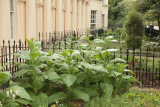
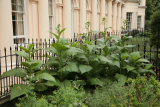

.JPG)
.JPG)
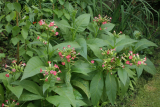
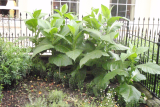
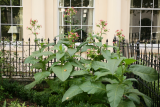
.JPG)
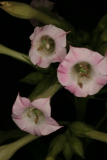
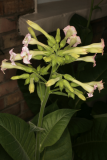
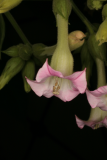
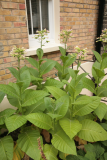

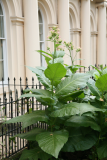
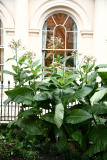
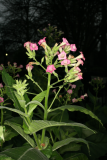
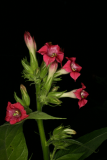
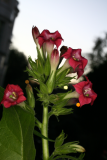
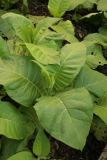
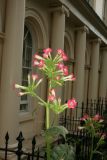
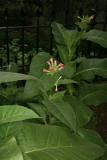

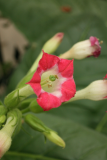
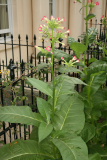
.JPG)
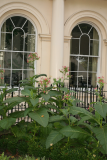
.JPG)
.JPG)